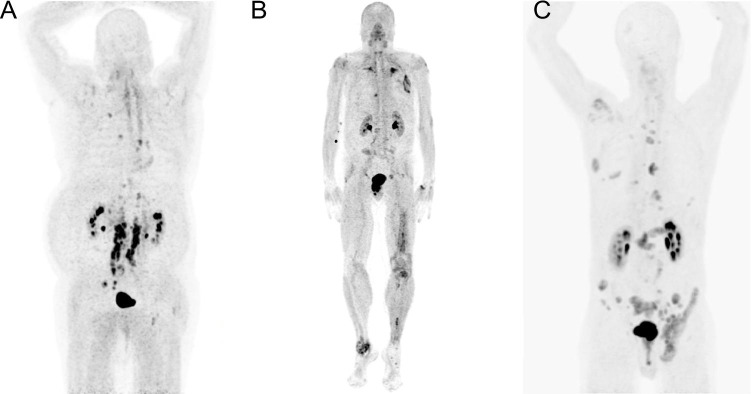Fig. 2.
[68 Ga]Ga-FAPI-04 PET/CT in patients with castration-resistant prostate cancer. Maximum intensity projections of three patients undergoing [68 Ga]Ga-FAPI-04 PET/CT: (A) A 77-year-old patient diagnosed with PC in 2001, progressing after standard androgen deprivation therapy, abiraterone, docetaxel, enzalutamide, cabazitaxel, and [177Lu]Lu-PSMA-617-RLT; [68 Ga]Ga-FAPI-04 PET/CT demonstrating bone and LN metastases; another image of this patient has been published previously [14]; (B) A 70-year-old patient diagnosed with PC in 2007 undergoing radical prostatectomy (pT3b, pN1, R1, GS 5 + 3 = 9, ISUP 5, M0) followed by radiation to the prostatic bed and pelvic LN, first-generation antiandrogen therapy, multiple resections of pulmonary metastases, docetaxel chemotherapy, and enzalutamide, finally progressing under treatment with olaparib (confirmed somatic BRCA2 mutation); [68 Ga]Ga-FAPI-04 PET/CT demonstrating bone and pulmonary metastases; (C) A 71-year-old patient initially diagnosed with metastatic PC in 2016 presenting a mixed phenotype of 20% adenocarcinoma and 80% neuroendocrine cancer. Currently progressing after treatment with three-cycle cisplatin/etoposide chemotherapy and immunotherapy (nivolumab + ipilimumab); [68 Ga]Ga-FAPI-04 PET/CT demonstrating bone and LN metastases; a different image of this patient has been published previously in another context [10]

